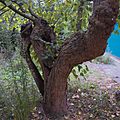Bethnal Green mulberry tree facts for kids
The Bethnal Green mulberry tree is a very old black mulberry tree in Bethnal Green, a part of London. People think this tree is between 150 and 400 years old. It might be the oldest tree in the East End of London!
Contents
The Tree's Long History
The Bethnal Green mulberry tree stands near Bonner Road. Hundreds of years ago, in the mid-1500s, this area was part of Bishop Bonner's palace gardens. A famous book from 1563 even shows Bishop Bonner next to a young tree. Some people believe this small tree was the very same mulberry tree we see today!
In the 1600s, a nearby area called Spitalfields was famous for making silk. Silk comes from silkworms, which eat white mulberry leaves. King James I accidentally brought many black mulberry trees to London instead of white ones. The Bethnal Green mulberry tree might be one of those trees!
Old Records of the Tree
There's a special piece of evidence at the Royal London Hospital in Whitechapel. In 1911, a piece of wood from a broken branch of the mulberry tree was saved. It was said to be from the tree where Bishop Bonner used to sit in the cool evenings.
Later, in 1855, the London Chest Hospital opened on the tree's site. Nurses from the hospital would even dance around the tree during their free time!
Surviving a Bomb Attack
During the last few months of the Second World War in 1945, a bomb hit the London Chest Hospital. The hospital's chapel was destroyed, but the mulberry tree survived! You can still see burn marks on the tree today from that time.
Saving the Ancient Tree
Since 2017, there has been a big discussion about the Bethnal Green mulberry tree.
In 2015, the London Chest Hospital closed. A company bought the land to build new homes. In 2017, they got permission to move the mulberry tree. This was before they even submitted their full building plans.
Why Moving the Tree Was Risky
The Bethnal Green mulberry tree has a special rule called a Tree preservation order. This rule protects important trees. People argued that the tree was much older than first thought. They said it was a "veteran" tree, which means it's very old and important.
Rules say that very old trees like this should not be moved or harmed unless there are very special reasons. Experts said that moving such an old tree was very risky. Julian Forbes Laird, an expert, said in 2018 that moving the tree would likely cause it to "fall apart or die."
Community Efforts to Protect It
Many local people wanted to save the tree. The East End Preservation Society started a petition called 'Save the Bethnal Green Mulberry' in 2017. By September 2018, over 10,000 people had signed it! The local council also received 300 letters from people who did not want the tree moved.
In September 2018, the council committee voted on the building plans, which included moving the tree. Three councillors voted against the plans, but four voted for them. So, it was decided that the tree would be moved to a new spot on the lawn in front of the old hospital entrance.
Images for kids



